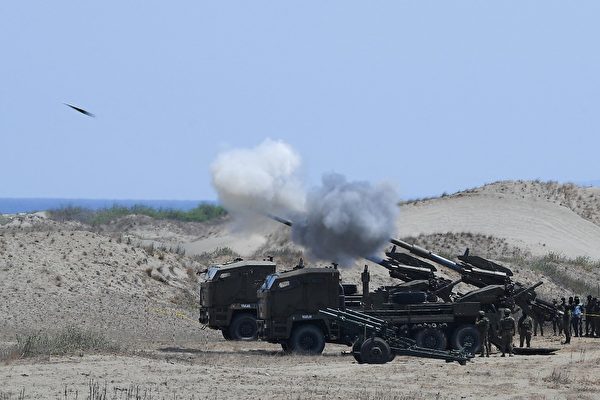In a joint military exercise conducted near Taiwan on Wednesday, May 8, the US and Philippine military forces, with support from Australian Air Force reconnaissance planes, launched a series of high-precision rockets, shells, and air strikes, successfully sinking a simulated enemy ship made in China. The Chinese government has expressed dissatisfaction multiple times regarding the use of Chinese-made simulated enemy ships by the US and the Philippines. The Philippine Ambassador to the US warned China, saying, “You have warships, but the US and the Philippines have powerful firepower capable of sinking them all.”
According to a report from the Inquirer, the simulated enemy ship was none other than the retired Philippine Navy supply ship BRP Lake Caliraya. The simulated combat took place approximately 15 kilometers off the coast of Laoag, a coastal city in the Philippines, just over 400 kilometers from the southern tip of Taiwan.
The event, attended by military officials and diplomats from various nations, including the US, took place on a mountaintop overlooking Laoag City in Ilocos Norte, the hometown of Philippine President Ferdinand Marcos Jr. Witnesses reported seeing black smoke emerging from the rear of the simulated enemy ship during the live firepower demonstration.
The chief planner of the exercise, Omar Al Assaf, informed Central News Agency that around 1,500 Philippine troops and 500 American troops participated in the military exercise on Wednesday. The exercise involved naval, air, and ground artillery units conducting a maritime attack aimed at preventing aggressors from landing in the Philippines.
Al Assaf explained that the Philippine Navy’s Fast Attack Interceptor Craft (FAIC) was the first to launch an attack, using Spike Non-Line-of-Sight (NLOS) missiles that hit the upper structure of the BRP Lake Caliraya. Following that, Philippine Air Force helicopters, AgustaWestland AW109s, engaged the simulated enemy ship, and the Philippine Navy patrol vessel also launched C-Star surface-to-surface anti-ship missiles, hitting the aft section of the ship, causing it to slowly sink.
The Philippine Air Force’s FA-50 and US F-16 fighter jets subsequently fired AGM-65 Mavericks and GBU-54 guided bombs, targeting and repeatedly hitting the upper structure of the ship. The US AC-130 gunship then fired 105mm howitzers, followed by the Philippine Army’s artillery unit firing 155mm howitzers, successfully sinking the simulated enemy ship.
This military exercise is part of the annual “Shoulder-to-Shoulder” maneuvers between the US and the Philippines. The exercise began on April 22 and will conclude on May 10. The use of Chinese-made simulated enemy ships in the exercise has drawn criticism from China.
An article in the Global Times, a Chinese state-owned publication, pointed out that the BRP Lake Caliraya, formerly known as the Rapsa-Rapsa, was constructed in a Chinese shipyard and stood witness to previous cooperation between China and the Philippines. The decision by the Philippine side to designate it as a target for simulated combat was seen as a deliberate provocation, according to the report.
In response, a spokesperson for the Chinese Ministry of Foreign Affairs, Lin Jian, stated during a regular press briefing on May 7 that military exercises should not target third parties or harm their interests. He emphasized that countries should refrain from maritime provocations and confrontations and work towards actions that promote regional peace and stability rather than seeking self-assurance through what he labeled as “psychological victory tactics.”
Chief planner of the US-Philippine exercise, Al Assaf, countered, stating, “Defending our nation is our duty, not just for specific individuals or countries.”
While the Philippine military has clarified that the selection of the Chinese-made BRP Lake Caliraya as a simulated enemy ship was not intentional, the Eurasian Times reported it as a subtle warning to China.
Jose Romualdez, the Philippine Ambassador to the United States, stressed in an interview with the Associated Press that the Philippines feels threatened, lacking sufficient resources to counter Chinese bullying. He highlighted the importance of alliances, particularly with the US and like-minded partners, to demonstrate to China that despite their warships, the combined firepower of the US and Philippines could overpower them.
China’s provocative actions in the South China Sea have become a significant concern for the Philippines. President Marcos has shifted the military’s focus from decades-long internal rebellions to external defense against potential threats. This strategic pivot aligns with the US government’s efforts to strengthen alliances in the Indo-Pacific region to counter China’s influence.
In close proximity to the South China Sea, this year’s US-Philippine “Shoulder-to-Shoulder” military exercises also serve as preparation for potential conflicts in the Taiwan Strait. Special forces from both countries conducted island seizure exercises in the Batanes Islands, less than 200 kilometers from Taiwan.
Jay Batongbacal, the director of the University of the Philippines Institute for Maritime Affairs and Law of the Sea, had previously stressed to Central News Agency that in the event of a Chinese invasion of Taiwan, controlling the strategically positioned Batanes Islands to thwart enemies approaching Taiwan from the south would be crucial.

